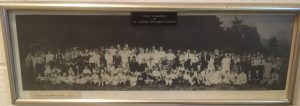Pertaining to the United States as a whole, the first wave of Greek migration began at the end of the 19th century and continued until about 1920. This wave witnessed the arrival of about 400,000 Greeks, who hailed predominately from Peloponnese and Southern Greece. At the end of World War I, the United States withdrew from international politics and chose a new identity of isolationism. As a result, immigration quotas were sharply limited and immigration policy began to reflect the United States’ withdrawn tone.
While migration from Greece temporarily stopped, there was a significant Greek population already established in the country. The largest Greek communities appeared in urban areas such as Chicago and New York City; however, there were Greeks spread throughout America, residing both in urban and rural geographical locations. Greek labor was represented across many different occupations, working as street vendors, shop owners, textile mill workers, railroaders, and coal miners. In the cities, newspapers, schools, coffee shops and churches were all established to serve the needs of the Greek communities.
The 1920’s signified an increase in American xenophobia, resulting in strict Americanization campaigns across the U.S. In other words, assimilation into American culture became a necessary requirement for all immigrants and their children. While some migrant groups struggled to assimilate, the Greeks responded well to a shift in culture. After all, living in the United States provided the Greeks with far more economic opportunities than Greece could offer.
After World War II, the United States opened itself back up to the world, thus loosening immigration quotas. Greece had been ravaged from a war with Italy and because of Nazi German occupation. Therefore, it is unsurprising that Greek immigration began to increase in the mid-1940’s and 1950’s. Migration peaked in the late 1960’s and 1970’s after the passage of the Immigration and Nationality Act in 1965, in which whole families were permitted to reunite in the U.S.
This time period also witnessed the growth of strong nationalist pride among Greek immigrants and Greek-Americans. In the 1960’s, a so-called “revival of ethnicity” occurred, whereas cultural roots and traditions were recognized, celebrated, and disseminated throughout America. In addition, Greek communities fully embraced a turn to the ideological left. Examples of this include Greek support for the Civil Rights movements and Greek women’s feminist enthusiasm, resulting in the loss of some old, outdated patriarchal traditions.
Finally, in the 1980’s, Greek immigration became a popular research topic among historians. Academics produced analyses on Greek immigration, assimilation, and overall success in the United States. These works followed the new academic trend of social history-studying the experiences of African Americans, women, and immigrants- which became popular in American universities and colleges.
The Greek community in the Berkshires (Western Massachusetts), strongly reflects the overall historical context of Greek migration to the United States as a whole. The Greek community ‘officially’ became established in the early 1920’s, represented by the construction of St. George’s Greek Orthodox Church, which immediately served as a community headquarters. Thus, the community was founded by those Greek migrants who came to the United States prior to the tightening of immigration quotas. Then, migration into Pittsfield heavily increased again after World War II due to the wrecked economy of Greece.

The founders of St. George’s Greek Orthodox Church
The Greek community in Pittsfield was largely employed by industrial manufacturing plants, predominately General Electric. In addition, the community flourished because of the entrepreneurial spirit of the Greek migrants, which gave the community relatively strong financial autonomy. However, since industry left Western Massachusetts, Pittsfield has become a bastion of joblessness and drug use. Most of the community members have either passed away or moved, as evidenced by the declining number of Greeks who attend St. George’s religious services.
Below, this mapping digital tool showcases some of the connections between Greece and the Berkshires.
- Kitroeff, Alexander. “The Journey: The Greek American Dream – A Documentary by Maria Iliou.” The Story of Greek Migration to America, The Journey Greek-American Dream, http://thejourneygreekamericandream.org/
- Pierce, Bethany E. “Greek Immigrants.” Greek Immigration to the United StatesImmigration to the United States, 2015, www.immigrationtounitedstates.org/529-greek-immigrants.html.
- St. George’s Greek Orthodox Church. “St. George’s Greek Orthodox Church: Pittsfield, MA.” christisrisen.com/.
- “The World Factbook – Greece.” Central Intelligence Agency. 22 Feb. 2018.https://www.cia.gov/library/publications/the-world-factbook/geos/gr.html.